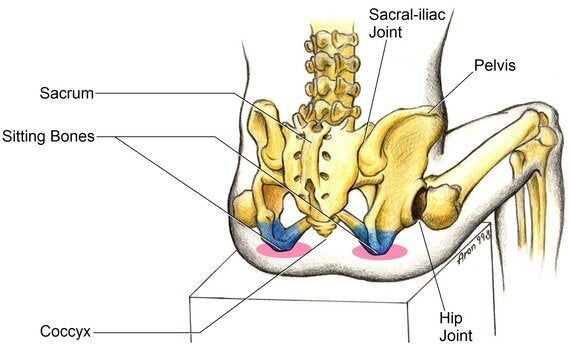Seeing as I spent my last blog debunking the usefulness of ergonomic chairs, as they can't do the sitting for you, it only seems fair that I follow up with my take on what sitting actually is in the first place.
I don't like to take an overly anatomical view on these things, too much detail to think about in day to day living. I'm much more interested in the "way" we think and react, rather than "what" we think about, but this is something really useful for you to consider.
So let's get the anatomy lesson out of the way first. Look at how the bottom of the spine (the sacrum) fuses with the pelvis. What changes to that relationship when the weight bearing changes from going through your hips, and ultimately to the ground via your feet, to going through your sit bones into your chair? Not much! You'll notice that both the hip joints and the sit bones are below the sacral-iliac joint, that is, where the base of the spine, the sacrum, fuses with the pelvis.

Picture by Aron Cserveny and used with permission by Tim Soar MSTAT
As far as your spine is concerned, sitting and standing is pretty much the same thing, so why do you sit so differently to the way you stand? One reason is that you may simply not be aware that your sit bones are there to be sat on, or "stood" on as I like to say. It's common to see people using their coccyx, or tail-bone, to be the point of contact with the chair which causes the pelvis to tip backwards and rounding the lower back, hence the lower back pain many eventually suffer from sitting in this way.
The surface that you sit on is also a huge contributing factor in how you sit, but as long as it is flat and firm it will do. My motto is "if you can stand on it, you can sit on it". Ignoring that most office chairs swivel, it's the support that the surface provides I'm interested in here, so I don't want you to have an accident at work now!
This is why sofas are so hard to sit on well. Try standing on your sofa and you'll soon find how hard it is to feel balanced. With your sit bones as your "feet" it is no wonder that sitting on a sofa is hard to do as well, and you give up by collapsing into it.
Another reason is that the act of sitting is incorrectly associated with relaxing. Sure, it's more relaxing for the legs and hips, but as far as your torso/spine is concerned, sitting is as equally dynamic as standing. Even the word "relax" seems to be misunderstood, I'm often heard saying during my Alexander Technique lessons"that's not relaxing, that's collapsing!" It is perfectly possible to relax into a balanced posture, whether sitting or standing, so that our bones support our weight. Watch how a young child sits. Yes, the postural muscles will still be working, but think of them as having tone rather than tension. It is when poise and balance is lost in collapse that movement muscles, as well as the deeper postural muscles, become over-worked trying to support the collapse that tension arises; that's not relaxing at all!
If your office chair tilts backwards allowing you to come to rest against the back support this is still likely to be another form of collapse. You could think of this as elegant repose in order to do it well, but if you are honest with yourself you'll have allowed the muscle tone of your torso to go limp. And what's wrong with that if your back is being supported? Well, your arms are an extension of your back!
Don't make the mistake of thinking your arms are simply attached to your shoulders, that may be true as far as the skeleton is concerned, but your arm muscles overlap and are embedded deep into your torso, all the way down your back to the top of your pelvis. So if you lose the integrity and tone of your back you will lose the support from the roots of your arms, and without that the use of your hands is compromised potentially contributing to RSI and Carpal Tunnel Syndrome.
As with many aspects of the Alexander Technique, there is also the way you think to consider. Like the association of relaxing being inert. The very phrase, sitting "down", encourages the thought that that is where you are wanting to go in your entirety. What you don't want to do is remedy that by doing the opposite, by "sitting up straight" as you were no doubt told to do as a child, as that encourages effort, and effort will lead to tension. That's why it is so tiring to "sit up straight" as it is commonly understood. Instead, just remain lightly standing, but on your bottom, being bright, alert, active and engaged. If you start to feel tired it's fine to use the back rest (still thinking of elegant repose!) and take time out for a few minutes, just don't use your computer like this. Better still, get up and walk around and get your blood pumping again.
"Every simple act must be approached as if we have never done it before. Then we can find things out." - F.M. Alexander
This blog was originally posted here.
The Alexander Technique has been clinically proven for back pain via an NHS funded, gold standard randomised trial. It was performed by Southampton University and their results were published in the British Medical Journal.
World wide resource for the Society of Teachers of The Alexander Technique: www.stat.org.uk